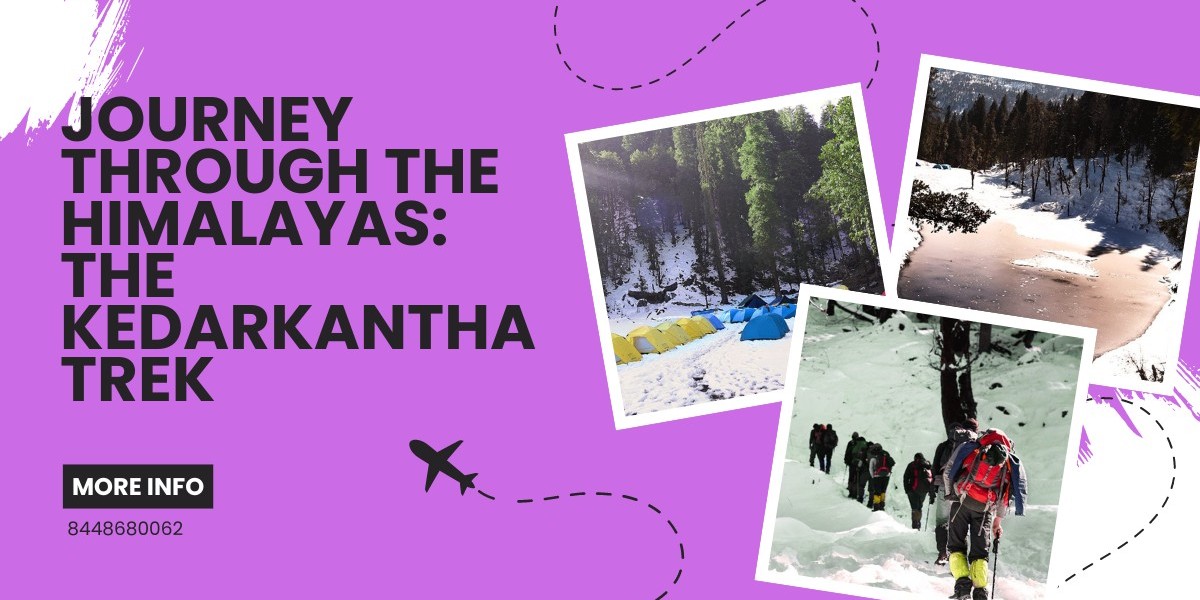The Kedarkantha trek is a remarkable adventure that takes you through the heart of the Indian Himalayas, offering breathtaking views, serene landscapes, and an exhilarating experience for both novice and seasoned trekkers. Known for its stunning scenery and relatively easy trail, the Kedarkantha trek has become a favorite destination for winter trekking enthusiasts. This guide will provide an in-depth look at the trek, including what to expect, how to prepare, and why this journey is a must-do for every adventure seeker.
1. Introduction to Kedarkantha Trek
The Kedarkantha trek is a winter wonderland, nestled in the Uttarkashi district of Uttarakhand, India. Standing at an altitude of 12,500 feet, the Kedarkantha peak offers a panoramic view of some of the most majestic mountains in the Himalayas, including Swargarohini, Bandarpoonch, and Black Peak. The trek begins from a quaint village called Sankri and spans a distance of approximately 20 kilometers, making it an ideal choice for those seeking a moderate-level trekking experience.
2. The Best Time to Trek Kedarkantha
While the Kedarkantha trek can be done throughout the year, the best time to experience its full glory is during the winter months, from December to April. During this period, the trail is blanketed with snow, transforming the landscape into a picturesque snowy wonderland. The snow-capped peaks, frozen lakes, and pristine white surroundings create a magical atmosphere that is perfect for those looking to experience the beauty of the Himalayas in winter.
3. Getting There: How to Reach Sankri
Sankri, the base camp for the Kedarkantha trek, is well connected to major cities like Dehradun and Delhi. The most convenient way to reach Sankri is by road from Dehradun, which is about 200 kilometers away. You can hire a taxi or take a bus from Dehradun to Sankri. The drive takes approximately 8-10 hours, winding through picturesque landscapes and passing through charming villages like Mussoorie, Nainbagh, and Purola.
4. Trek Itinerary: A Day-by-Day Breakdown
Day 1: Arrival in Sankri
Your journey begins with your arrival in Sankri, a small village nestled amidst the pine forests of Uttarakhand. Sankri serves as the gateway to the Kedarkantha trek and offers basic accommodation options. Spend the evening acclimatizing to the altitude and preparing for the trek ahead.
Day 2: Sankri to Juda Ka Talab
The trek officially begins from Sankri, taking you through dense pine forests, oak trees, and clearings. The first major stop is Juda Ka Talab, a high-altitude lake surrounded by dense forests. This serene spot is ideal for setting up camp and spending the night under the starlit sky. The trek from Sankri to Juda Ka Talab is about 4 kilometers and takes approximately 4-5 hours.
Day 3: Juda Ka Talab to Kedarkantha Base Camp
The next leg of the trek takes you from Juda Ka Talab to the Kedarkantha Base Camp. The trail is moderately steep and passes through lush forests and open meadows. As you ascend, you’ll catch glimpses of snow-covered peaks and the vast expanse of the Himalayas. The Kedarkantha Base Camp is a stunning location, offering panoramic views of the surrounding peaks. The trek from Juda Ka Talab to the base camp is about 4 kilometers and takes around 3-4 hours.
Day 4: Kedarkantha Summit and Return to Base Camp
The most exhilarating part of the trek is the summit climb to Kedarkantha. Starting early in the morning, you’ll trek through knee-deep snow, navigating steep sections and rocky terrain. The effort is well worth it as you reach the summit and are rewarded with breathtaking 360-degree views of the Himalayas. After spending some time at the summit, you’ll begin your descent back to the base camp. The entire trek to the summit and back takes about 7-8 hours.
Day 5: Descent to Sankri
On the final day, you’ll make your way back to Sankri, retracing your steps through the beautiful landscapes you crossed earlier. The descent is relatively easier and faster, taking about 4-5 hours. Once back in Sankri, you can relax and celebrate the successful completion of the Kedarkantha trek.
5. What to Pack for the Kedarkantha Trek
Packing the right gear is essential for a successful and comfortable trek. Here’s a list of must-have items for the Kedarkantha trek:
- Clothing: Warm layers, thermal wear, fleece jackets, waterproof jackets, and trekking pants.
- Footwear: Sturdy trekking boots with good grip and waterproofing, woolen socks, and gaiters.
- Accessories: Woolen gloves, hats, sunglasses, sunscreen, and a trekking pole.
- Camping Gear: Tent, sleeping bag, and a sleeping mat (if not provided by your trekking company).
- Other Essentials: A first aid kit, water bottles, energy snacks, and personal hygiene items.
6. Preparing for the Kedarkantha Trek
While the Kedarkantha trek is considered moderate, it’s important to be physically prepared for the journey. Here are some tips to help you get ready:
- Cardiovascular Training: Engage in regular cardio exercises like running, cycling, or swimming to build stamina.
- Strength Training: Focus on strengthening your legs and core muscles to handle the steep ascents and descents.
- Altitude Acclimatization: Spend a day or two at Sankri to acclimatize to the altitude before starting the trek.
- Mental Preparation: The trek can be challenging, especially in snowy conditions, so it’s important to be mentally prepared and stay positive throughout the journey.
7. Flora and Fauna: Nature’s Bounty on the Kedarkantha Trek
The Kedarkantha trek is not just about the views and the adventure; it’s also a journey through diverse flora and fauna. The trail is lined with oak, pine, and maple trees, creating a lush green canopy in the summer and a snow-covered wonderland in the winter. You might spot various bird species, such as Himalayan Monal and Eurasian Jay, and if you’re lucky, you might even catch a glimpse of the elusive Himalayan wildlife, like the barking deer or the mountain fox.
8. Cultural Insights: The Villages Along the Trek
The Kedarkantha trek also offers a chance to experience the rich culture of the Garhwali people. As you pass through villages like Sankri, you’ll get to witness the traditional lifestyle, local customs, and hospitality of the Himalayan communities. Engaging with the locals and learning about their way of life adds a unique cultural dimension to the trek, making it more than just an adventure but a holistic experience.
9. Environmental Responsibility: Leave No Trace
As more people discover the beauty of the Kedarkantha trek, it’s crucial to practice responsible trekking. Here are some tips to minimize your environmental impact:
- Carry Back All Waste: Ensure you don’t leave any litter on the trail. Pack out all your trash, including biodegradable waste.
- Avoid Single-Use Plastics: Use reusable water bottles and containers to reduce plastic waste.
- Respect Wildlife: Keep a safe distance from wildlife and avoid disturbing their natural habitat.
- Stay on the Trail: Stick to the designated trekking path to prevent soil erosion and damage to the vegetation.
10. Why Kedarkantha Trek is a Must-Do Adventure
The Kedarkantha trek is more than just a trek; it’s an adventure that offers a perfect blend of natural beauty, cultural experiences, and personal challenges. The breathtaking views, the thrill of summiting a peak, the camaraderie with fellow trekkers, and the opportunity to disconnect from the hustle and bustle of everyday life make this trek an unforgettable journey. Whether you’re a seasoned trekker or a beginner looking to explore the Himalayas, the Kedarkantha trek is an experience that should be on your bucket list.
Conclusion
The Kedarkantha trek is a journey that captures the essence of trekking in the Himalayas. With its stunning landscapes, rich cultural experiences, and the thrill of adventure, it offers something for everyone. Whether you’re seeking solitude in nature, the joy of reaching a summit, or the camaraderie of a group trek, Kedarkantha has it all. So pack your bags, lace up your boots, and set off on this incredible journey through the Himalayas – the Kedarkantha trek awaits!









